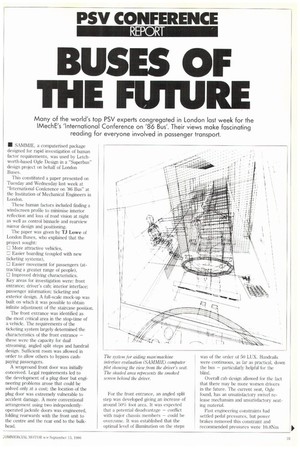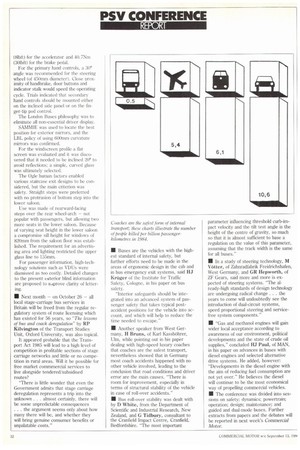BUSES OF 111 FUTURE
Page 33

Page 34

If you've noticed an error in this article please click here to report it so we can fix it.
Many of the world's top PSV experts congregated in London last week for the IMechE's 'International Conference on '86 Bus'. Their views make fascinating reading for everyone involved in passenger transport.
• SAMMIE, a computerised package designed for rapid investigation of human factor requirements, was used by Letchworth-based Ogle Design in a "Superbus" design project on behalf of London Buses.
This constituted a paper presented on Tuesday and Wednesday last week at "International Conference on '86 Bus" at the Institution of Mechanical Engineers in London.
These human factors included finding a windscreen profile to minimise interior reflection and loss of road vision at night as well as control binnacle and rearview mirror design and positioning.
The paper was given by TJ Lowe of London Buses, who explained that the project sought: O More attractive vehicles, E Easier boarding (coupled with new ticketing systems), O Easier movement for passengers (attracting a greater range of people), 0 Improved driving characteristics. Key areas for investigation were: front entrance; driver's cab; interior interface; passenger information; ticketing and exterior design. A full-scale mock-up was built on which it was possible to obtain infinite adjustment of the staircase position.
The front entrance was identified as the most critical area in the stop-time of a vehicle. The requirements of the ticketing system largely determined the characteristics of the front entrance — these were the capacity for dual
streaming, angled split steps and handrail design. Sufficient room was allowed in order to allow others to bypass cashpaying passengers.
A wrapround front door was initially conceived. Legal requirements led to the development of a plug door but engineering problems arose that could be solved only at a cost; the location of the plug door was extremely vulnerable to accident damage. A more conventional arrangement using two independentlyoperated jacknife doors was engineered, folding rearwards with the front unit to the centre and the rear end to the bulkhead.
The system for aiding man/machine interface evaluation (SAMMIE) computer plot showing the view from the driver's seat. The shaded area represents the smoked screen behind the driver.
For the front entrance, an angled split step was developed giving an increase of around 50% foot area. It was expected that a potential disadvantage — conflict with major chassis members — could be overcome. It was established that the optimal level of illumination on the steps
was of the order of 50 LUX. Handrails were continuous, as far as practical, down the bus — particularly helpful for the blind.
Overall cab design allowed for the fact that there may be more women drivers in the future. The current seat, Ogle found, has an unsatisfactory swivel release mechansint and unsatisfactory seating material.
Past engineering constraints had settled pedal pressures, but power brakes removed this constraint and recommended pressures were 10.8Nin (8lbft) for the accelerator and 40.7Nni (30lbft) for the brake pedal.
For the primary hand controls, a 30° angle was recommended for the steering wheel (of 450mm diameter). Close proximity of handbrake, door buttons and indicator stalk would speed the operating cycle. Trials indicated that secondary hand controls should be mounted either on the inclined side panel or on the finger-tip pod control.
The London Buses philosophy was to eliminate all non-essential driver display.
SAMMIE was used to locate the best position for exterior mirrors, and the LBL policy of using 600rnin curvature mirrors was confirmed.
For the windscreen profile a flat screen was evaluated and it was discovered that it needed to be inclined 20° to avoid reflections; a simple, curved glass was ultimately selected.
The Ogle human factors enabled various staircase exit designs to be considered, but the main criterion was safety. Straight steps were preferred with no protrusion of bottom step into the lower saloon.
Use was made of rearward-facing steps over the rear wheel-arch — not popular with passengers, but allowing two more seats in the lower saloon. Because of varying seat height in the lower saloon a compromise sill height for windows of 820mm from the saloon floor was established. The requirement for an advertising area and lighting restricted the upper glass line to 155mm.
For passenger information, high-technology solutions such as VDUs were dismissed as too costly. Detailed changes to the present exterior blind information are proposed to improve clarity of lettering.
• Next month — on October 26 — all local stage-carriage bus services in Britain will be freed from the regular regulatory system of route licensing which has existed for 56 years, so The lessons of bus and coach deregulation" by RP Kilvington of the Transport Studies Unit, Oxford University, was also topical.
It appeared probable that the Transport Act 1985 will lead to a high level of competition in profitable sections of stage carriage networks and little or no competition in rural areas. Will it be possible for free market commmercial services to Live alongside tendered/subsidised routes?
"There is little wonder that even the Government admits that stage carriage deregulation represents a trip into the unknown. . almost certainly, there will be some unpredictable consequences . . the argument seems only about how many there will be, and whether they will bring genuine consumer benefits or unpalatable costs." Coaches are the safest form of internal transport,' these charts illustrate the number of People killed per billion passengerkilometres in 1984.
• Buses are the vehicles with the highest standard of internal safety, but further efforts need to be made in the areas of ergonomic design in the cab and in bus emergency exit systems, said Hi Kruger of the Institute for Traffic Safety, Cologne, in his paper on bus safety.
"Interior safeguards should be integrated into an advanced system of passenger safety that takes typical postaccident positions for the vehicle into account, and which will help to reduce the time needed to escape."
• Another speaker from West Germany, H Bruns, of Karl Kasshohrer, Ulm, while pointing out in his paper dealing with high-speed luxury coaches that coaches are the safest transport, nevertheless showed that in Germany most coach accidents happened with no other vehicle involved, leading to the conclusion that road conditions and driver error are the main causes. "There is room for improvement, especially in terms of structural stability of the vehicle in case of roll-over accidents."
• Bus roll-over stability was dealt with by D White, from the Department of Scientific and Industrial Research, New Zealand, and G Tidbury, consultant to the Cranfield Impact Centre, Cranfield, Bedfordshire. "The most important
parameter influencing threshold curb-impact velocity and the tilt test angle is the height of the centre of gravity, so much so that it is almost sufficient to base a regulation on the value of this parameter, assuming that the track width is the same for all buses."
• In a study of steering technology, M Witter, of Zahnradfabrik Freidrichshafen, West Germany, and GR Hepworth, of ZF Gears, said more and more is expected of steering systems. "The already-high standards of design technology are undergoing radical change . . . the years to come will undoubtedly see the introduction of dual-circuit systems, speed proportional steering and servicefree system components."
• "Gas and methanol engines will gain wider local acceptance according to awareness of our environment, political developments and the state of crude oil supplies," concluded HJ Paul, of MAN, in his paper on advances in buses with diesel engines and selected alternative drive systems. He added, however: "Developments in the diesel engine with the aim of reducing fuel consumption are not yet over." He believes the diesel will continue to be the most economical way of propelling commercial vehicles.
• The conference was divided into sessions on safety; dynamics; powertrain; operation; design; maintenance; and guided and dual-mode buses. Further extracts from papers and the debates will be reported in next week's Commercial Motor.




























































































